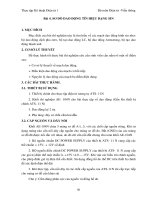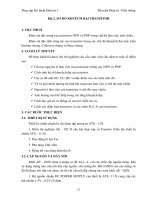Giáo trình tiếng anh điện tử viễn thông - digital telephone exchanges p2 pot
Bạn đang xem bản rút gọn của tài liệu. Xem và tải ngay bản đầy đủ của tài liệu tại đây (216.39 KB, 8 trang )
Unit 6. Digital Telephone Exchanges
87
Allison:
Gibbs:
Allison:
động nếu đường dây của người tôi gọi đến đang bận khi tôi gọi?
Được. Xin đừng quên rằng hệ thống này chỉ làm việc nếu cả ông và máy ông gọi tới
cùng nằm trong một hệ thống. Đối với cuộc gọi nội bộ, đây hiển nhiên là trường hợp
PABX. Ông quay số máy kia và nhận được âm báo bận. Rồi ông chỉ cần đơn gi
ản
nhấn số 4 và đặt máy. Khi người kia đặt máy, máy trong văn phòng ông sẽ rung
chuông, điều lần lượt cũng khiến cho máy trong văn phòng người kia cũng rung
chuông. Thật đơn giản, phải không?
Tôi nghĩ vậy. Ông cũng có thể cho tôi biết các chi tiết về các thiết bị tính cước hiện
có trong PABX?
Tất nhiên
4.1. Complete the table.
a. ii) Wait for the dial tone.
b. ii) Wait for the internal dial tone. iv) Wait for the dial tone of the outside network.
v) Dial the outside number.
c. iii) Push button 8.
iv) Wait for the lower pitch dial tone v) Dial other extension number.
d. ii) You receive the engaged tone. iv) Replace your handset.
4.2. Indicate which of the following sentences are true or false.
1. F 2.T 3. F
4. T 5. T 6. F
4.3. Fill in the following spaces with suitable words or phrases.
1. a 2. b 3. a 4. b 5. a
6. b 7. a 8. b 9. a 10. b
Unit 7. Computer Communications
88
UNIT 7. COMPUTER COMMUNICATIONS
I. GIỚI THIỆU
Bài 7 giới thiệu một số dịch vụ trên nền tảng hợp tác và phát triển song song hai lĩnh vực viễn
thông và xử lý dữ liệu.
1. Mục đích yêu cầu
Sau khi nghiên cứu bài 7, sinh viên cần:
1. Nắm được định nghĩa một số dịch vụ - kết quả của sự kết hợp giữa viễn thông và xử lý số
liệu.
2. Nắm được quá trình phát triển dịch vụ
videotex.
3. Thành lập câu sử dụng cấu trúc dự báo.
4. Nắm vững ngôn ngữ sử dụng trên điện thoại để liên hệ công việc.
5. Thành lập câu định nghĩa về thiết bị, sản phẩm hay dịch vụ.
2. Tóm tắt nội dung
1. Các dịch vụ như videotex, fax, thư điện tử… đã và đang được sử dụng rộng rãi.
2. Mạ
ng số liên kết đa dịch vụ (ISDN) là sự kết hợp nhiều mạng viễn thông khác nhau.
3. Dịch vụ videotex - truyền văn bản bằng hình ảnh của Anh - đã qua một quá trình phát triển
và thành công với mục tiêu hướng về người sử dụng.
4. Câu dự báo thường được chia thành ba cấp độ: chắc chắn (certainty), có thể (probability)
và có lẽ (possibility).
5. Ngôn ngữ trên điện thoại có các cụm từ hữ
u dụng theo các mục đích cụ thể như: khẳng
định mình, xác định người gọi, nêu lý do gọi, để lại lời nhắn…
6. Từ các từ chỉ tên, phân loại và đặc điểm của một thiết bị, sản phẩm hay dịch vụ, có thể tạo
thành câu định nghĩa hoàn chỉnh.
II. NỘI DUNG
1. READING 1
Read the following extract from a speech about "Trends in Computer Communications”.
The present status of telecommunications is a result of a long evolution through more than
a hundred years. It is interesting to note that the old telegraph system used digital transmission.
When, many years later, telephony was introduced, analogue transmission was used. Telex, on the
other hand, worked with a digital technique while video transmission in principle uses analogue
transmission. Data communication is digital and a transition is now taking place where all
services, voice, text, data and picture - will be integrated in a basic digital network. This digital
Unit 7. Computer Communications
89
network will be an ideal carrier of data communications and will promote the growth of such
communications.
The development of data communications depends, to a great extent, on the development
of data processing. So far, all the signs indicate a trend towards remote data processing which
means a greater usage of data communications services. Indeed, a "marriage" of
telecommunications and data processing will be the result. This "marriage" will hopefully result in
a number of useful products. Already a range of specialized services is foreseen - in particular in
the text and picture communication field.
A number of new text services have been, or will be, introduced shortly:
Teletex is an international service enabling subscribers to exchange correspondence on an
automatic memory to memory basis, via telecommunications networks. As a successor to telex it
will use specially adapted word processors and electronic typewrites and enable a 3-page A4 letter
to be sent almost instantaneously from one end of the country to the other.
The Telefacsimile service is well established. This service provides for the transmission
and reproduction of still pictures and printed matter. Telefax has its biggest market in Japan where
the complexity of Japanese script makes this an ideal medium of transmission.
Videotex, viewdata in Britain, is now available in many countries. Videotex is a service
enabling a subscriber to obtain information over the public switched telecoms network (PSTN) for
presentation in alphanumeric and and/ or graphic form on a VDU - usually a specially adapted TV
receiver.
Videotex subscribers may choose to have an additional service - electronic mailbox
enabling them to send messages directly and instantaneously to one another. The UK viewdata
system, which is an interactive service, should not be confused with Teletext, a one-way
information service which TV companies broadcast.
Technically it will be possible to integrate various types of telecommunications networks
(private and public, data and telephony) to form an Integrated Services Digital Network (ISDN).
In Germany the BIGFON experiment has been launched. BIGFON is a wide-band integrated
services local communications system, offering the subscribers the complete spectrum of
telecommunications services, including a new video telephone service as well as radio and TV
broadcasts, all transmitted via optical fibre cables.
Despite this development towards ISDN, a number of specialized networks will have to
live side by side for many years to come. From the customer's point of view, it is therefore
essential that networks and services are compatible. It should be possible to use one and the same
terminal for different services and to send traffic over different networks. The question is how can
this be realized? Could an integrated network be developed?
3.1. Phrases
- to a great extent: xét ở phạm vi rộng
- a 3-page A4 letter: lá thư ba trang A4
- especially adapted TV receiver: thiết bị thu truyền hình tương thích đặc biệt
- exchange correspondence: trao đổi thư tín
Unit 7. Computer Communications
90
- to live side by side: tồn tại song song
1.2. Classify the following services under Digital (D) or Analogue (A) transmission.
Transmission Services Transmission Services
A / D
A / D
A / D
1. telegraph
2. telephony
3. telex
A / D
A / D
3. video
4. data
1.3. Choose the best answers.
1. What does "remote data processing" mean?
a. data processing is carried out in one central place
b. the processing of different types of data
c. data processing is carried out in different geographical locations.
2. What feature which distinguish teletex from telex is mentioned?
a. Memory to memory transmission.
b. It provides for the production of still pictures and printed matter.
c. It enables subscribers to obtain information over the public switched telecoms network.
d. It is one-way information service which TV companies broadcast.
3. What other feature which distinguish teletex from telex is also mentioned?
a. Subscribers may choose to have an additional service - electronic mailbox.
b. Faster transmission speed.
c. It enables subscribers to obtain information over the public switched telecoms network
d. It is one-way information service which TV companies broadcast.
4. Why is Japan such a big market for Telefax?
a. Because it enables a 3- page A4 letter to be sent almost instantaneously from one end of
the country to the other.
b. Because of the complexity of Japanese script (i.e. it is not suitable for conventional
typewritten text communication).
5. What is the main difference between Viewdata and Teletext?
a. Viewdata is broadcast (one-way), Teletext is interactive.
b. Viewdata is interactive, Teletext is broadcast (one-way)
6. Why is it necessary for networks and services to be compatible?
a. Because they will have to live side by side for many years.
b. Because this can be realized.
Unit 7. Computer Communications
91
1.4. Match the names and the definitions.
Names Definitions
1. Telefacsimile
2. Videotex
3. BIGFON
4. Teletex
5. Teletext
6. Electronic
mailbox
a. one-way information service which TV companies broadcast.
b. a wide-band integrated services local communications system,
offering the subscriber the complete spectrum of
telecommunications services, all transmitted via optical fibre
cables.
c. provides for the transmission and reproduction of still pictures
and printed matter.
d. enables videotex subscribers to send messages directly and
instantaneously to one another.
e. an international service enabling subscribers to exchange
correspondence on an automatic memory to memory basis, via
telecommunications networks.
f. enables subscribes to obtain information over the public
switched telecoms network for presentation in alphanumeric
and and/ or graphic form on a VDU.
2. LANGUAGE PRACTICE
2.1. Dự báo (forecasting)
Khi nói về thời tương lai, ta chỉ ra mức độ có thể sẽ xảy ra của sự kiện theo ba cấp độ:
1. Certainty (chắc chắn) will/ won't + do
- More advanced systems will be introduced.
- It won't (will not) work out more than the existing telex.
- You will be getting a lot of new facilities.
2. Probability (có thể) should, will probably… + do
ought to, to be likely to…
- All the signs indicate that
- It should be possible
- The cost is likely to be a bit higher.
- We ought to be able to install a new system.
3. Possibility (có lẽ) might, could + do
- You might be interested
- That could be useful
Unit 7. Computer Communications
92
Practice 2.1. Now use the table below to do the exercises.
Installation Schedule for Extension Telephones.
Type of telephone
Special fast-rate
(15 pounds extra fee)
Business customers
Residential
customers
DIAVOX 3 - 5 days * 2 - 4 weeks 5 - 10 weeks
AMBASSADOR 3 - 5 days 3 - 5 weeks 4 - 6 weeks
MICKEY MOUSE 10 - 15 days 10 - 12 weeks
REGENCY 3 - 5 days 4 - 6 weeks 5 - 7 weeks
* In all cases: - first figure (3) represents a minimum waiting time for installation.
- last figure (5) represents a maximum waiting time for installation.
A. Match the two columns.
(1) If you need one in a hurry, we could deliver a Diavox in 3 days,
but you will have to pay 15 pounds extra.
(2) For a business customer we should/ought to be able to deliver an
Ambassador in 4 weeks.
(3) For a residential customer, we will install a Mickey Mouse
extension phone in 12 weeks.
Possibility
Probability
Certainty
B. Complete the sentences.
1. If you need an Ambassador soon, we deliver one in 5 days.
2. For a business customer, we deliver a Regency extension in 4 weeks.
3. It's be 6 weeks before we can install a Regency extension for a residential
subscriber.
4. We be able to deliver a Mickey Mouse extension set before 10 weeks.
5. All that delivery time will be around 7 or 8 weeks for the Diavox if you are a
residential subscriber.
6. We be able to install the Mickey Mouse in your house in 11 weeks time.
7. You receive the new Ambassador before 4 weeks if you are a residential
customer.
2.2. Liên lạc qua điện thoại (Telephoning)
Hãy lưu ý các cụm từ cần thiết trong liên lạc qua điện thoại.
• Identifying yourself Mr Binns speaking.
(khẳng định mình) This is Mr Binns.
• Identifying your caller Who's speaking, please?
(xác định người gọi)
• Getting connected Could you put me through to ?
Unit 7. Computer Communications
93
(được kết nối) Could I have extension 283?
• Waiting Hold on a moment, please.
(chờ máy) Would you mind holding?
I'll hold on.
• Taking a message I'm afraid Mr X is out at the moment.
(đề nghị để lại lời nhắn) Can I take a message?
• Leaving a message Could you give him a message?
Could you ask him to call me back on York 20042?
Could you tell him I'll call again later?
• Reason for phoning I'm phoning about / because
(lý do gọi điện)
• Communication problems I'm sorry, I didn't catch your number /your name.
(vấn đề trong liên lạc) Could you spell that, please?
It's a bad line, I'll call you back.
Could you/ repeat that? / speak up? (a little louder)
/speak more slowly?
• Singing off Thanks, goodbye.
(kết thúc cuộcgọi) Bye. (more informal).
Practice 2.2. A. Put the following jumbled telephone conversation in the correct order.
Đây là một cuộc nói chuyện qua điện thoại giữa 3 người (A, B, C). Trong đó A là điện thoại viên
tại tổng
đài cơ quan Amway International, B là ông Jackson (người gọi đến) và C là ông Barker
(người được gọi). Hãy đọc kỹ các câu và sắp xếp lại theo đúng trật tự, bắt đầu bằng câu 6a:
"Amway International. Can I help you?"
1 B: Hello, Mr Baker, this is Mr Jakeson. How are you?
2 C: Of course, I'll ring you as soon as my secretary gets back from lunch. Can I have your
number?
3 B: It's Mr Jakeson of Rushfords.
4 C: How do you spell Eindhoven?
5 B: Yes, but can you make it before 5?
6 A: Amway International. Can I help you?
7 B: Good, Goodbye.
8 C: M for Michael?
9 B: E, I, N
10 C: Fine, thanks. How can I help you?
11 B: Well, I'm phoning about our order no. 541.
12 A: Hold on a moment Mr Jakeson. I'll put you through.
13 C: Just a moment, I'll find the file I can't seem to find it. Can I call you back?
14 B: double O, two.
Unit 7. Computer Communications
94
15 C: Eindhoven 4, 8, 3 ?
16 A: Who's speaking, please?
17 C: Bye.
18 B: Yes, could you put me through to Mr Barker, please?
19 C: Thank you, I'll call you within the next hour or so.
20 B: Yes, it's Eindhoven 483002.
21 C: Barker speaking.
22 B: No, N for Nicholas, D, H, O, V, E, N.
1. 6A 2. … 3. … 4. … 5. …
6. … 7. … 8. … 9. … 10. …
11. … 12. … 13. … 14. … 15. …
16. … 17. … 18. … 19. … 20. …
21. … 22. …
B. These are standard phrases to start and finish telephone calls. Put them in suitable
purposes.
Example: 5. Confirming future plans: m. See you on the 26th, then.
a. Anyway
b. I'll look forward to seeing you on Tuesday,
then.
c. How are things?
d. Let me know if there’s anything I can do.
e. I'm phoning to ask
f. Thank you for calling.
g. The reason I’m phoning is
h. Nice to hear from you.
i. How are you?
j. Give me a ring if you have a problem.
k. Until Friday, then.
l. Have a nice day.
m. See you on the 26th, then.
Purposes Phrases
1. Welcoming the call
2. Polite enquiries
3. Saying why you're phoning
4. Indicating you're ready to finish
5. Confirming future plans m
6. Ending on a friendly note
2.3. Định nghĩa (Definitions)
Có thể tập hợp các phần: tên, phân loại và đặc điểm của một thiết bị, sản phẩm hay dịch vụ để tạo
thành câu định nghĩa hoàn chỉnh.
Ví dụ: Name: Lasers









